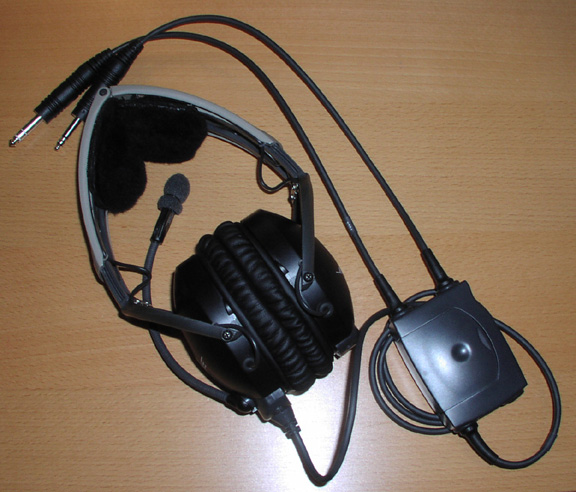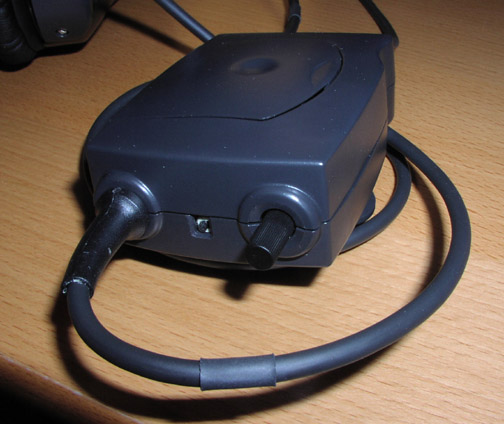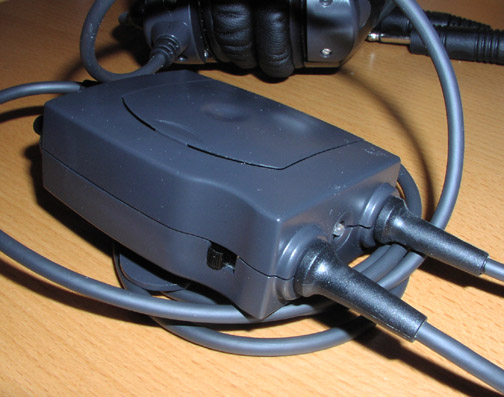Doug's 2001 Bose X
Active Noise Reduction Headset Review
A take on Bose's latest ANR headset design from the perspective of a former Bose Series I owner.
Note: This is NOT a review of Bose's "Improved
Bose X" marketed for sale in late 2003.
If you're looking for that, read my review of the 2003 Bose X.
Battery Box Detail
Here are some closeups of my new Bose X. The Bose X comes in "portable" and "installed" versions. As a CFI, I fly in many aircraft, hence my need for the portable version.
The battery box contains some basic electronics and a single 9V battery. The unit specifies an alkaline battery. As any Series I or II owner can attest, this new power source is really the best feature of the Bose X.The battery box has several external features:
A mono/stereo switch (permanently recessed) located in the center of the side panel as shown above. You'll need a sharp point of a pencil or similar to change the position of this switch.
The volume control is shown to the right of the mono/stereo switch. If you push on the knob, it alternately extends and retracts away from harm, and this is very cool.
What's not so cool is that when it's in the position shown in the photo, instead of altering the volume in both ears simultaneously (as it should, IMHO), it controls only one ear. To adjust the volume in the other ear (which in turn adjusts the balance between the two ears), you pull it out into another "detent". When done, you push it in again and it retracts.
Needless to say, this makes it rather difficult to precisely and quickly adjust the volume of the headset based on flight conditions. If you fly with others who have Bose X's or other ANRs, this shouldn't be a problem. Just crank up your Bose X's volume to maximum in both channels, and adjust the intercom and radio levels to suit everyone. However, if you fly with one or more passive headsets, you'll probably find that the passive headset will require the radio and intercom levels cranked up to the point that it hurts your ears. If that happens, expect to spend some time futzing with this stupid volume control. It really makes me wonder if Bose engineers work in a room with no windows...
On the other side of the box just to the left of the headset cable, shown above, is a simple black slide switch used to control power delivered to the ANR electronics. Turn this on and be prepared to hear the best noise reduction in the industry. Turn it off and be prepared to go deaf. This is NOT a good passive headset. The tri-port technology may have helped Bose develop a more efficient ANR design, but I think it causes resonances in the earcups that really make it unsuitable for use when the battery dies...at least in average single engine Cessnas that I fly. Solution? Carry extra batteries, or if you're like me and really paranoid about losing your hearing, a backup headset with (at least) passive noise reduction.
The two cables exiting to the bottom right of the picture are the traditional pair of cords used to connect to the aircraft's microphone and phone jacks. Thankfully, these are fairly long, which means they should reach jacks separated by a few inches. Wish I could say the same for David Clark and other headsets.
The LED status indicator, shown between the two input cords, flashes green once every few seconds to indicate normal operation, red/green to indicate fewer than 5 hours of battery life remain, and (naturally) off to indicate the power switch is off or the battery is stone dead. In my opinion, they should increase the duty cycle of the LED because in its current form it's easy to miss the green flash and recognize the unit is still on. Given the fact that the Bose X doesn't support APO (auto-power-off), they really should have designed this led indicator a bit better. Do I really care if I get a bit less runtime because the LED duty cycle has increased?
Attached to the bottom of the box is a spring-loaded clip that allows you to temporarily mount the box to help allieviate some of the weight of the cord from the headset or make it convenient to reach the power and volume controls.
Here's another closeup of the battery box, open this time. Look closely and you'll figure out that the only way the battery stays in contact with the metal contacts of the box is through the force of the foam pushing on the base of the battery. This is dumb simply because What if that foam piece gets torn or ripped, or simply comes off and is lost? The entire operation of the headset is subject to the integrity of a $0.02 piece of foam. Acceptable for a $20 toy, but shameful on a $1000 TSO'd headset.
Of course, as long as the foam is there, it gets the job done...in fact, too well by my standards. It produces such a tight fit that it's very difficult to remove the battery...especially in flight. I did that once and never want to repeat the experience. If Bose was committed to this blunder of a design, the LEAST they could have done was affix a nylon ribbon to the interior of the battery compartment that could be placed under the battery and used as an extraction aid.
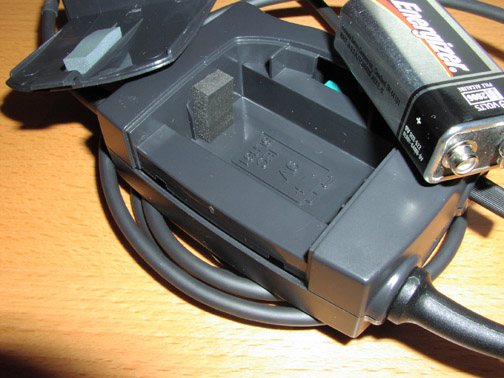
Headset Detail
Fortunately, the magic of this headset isn't necessarily in the battery box...it's in the earcups, which are, coincidentally, canted 15 degrees to the headband for comfort. In the following closeup you can see the silky-soft earseals. They contain a thermo-sensitive foam that is reasonably soft to begin with, but when brought up to temperature by one's body heat, really softens up to the point that you feel absolutely NO pressure points. No matter the temperature, I've found they seal very well around glasses (even better than the Series I silicone gel filled earseals, which were in many ways light-years ahead of their time).
As with the Series I, the Bose X earseals are field replaceable and Bose recommends replacing them once a year. I have to point out though, that this needs to be taken with a grain of salt...if you keep them clean as they recommend (wiping them down after flying with a soft damp cloth and then drying them) they should last many years. How do I know? The same material was used on my Oregon Areo softseals and they lasted about 6 years before age caused the backing material to delaminate from the "leatherlike" surface you see.
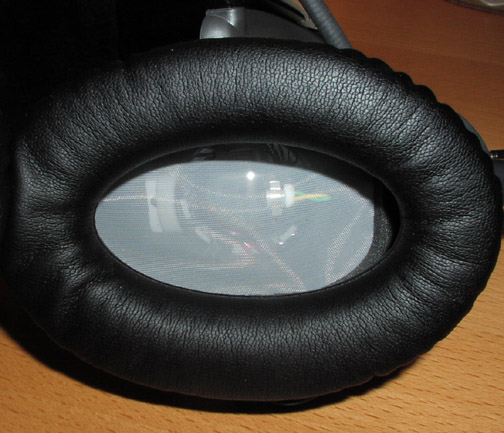
The translucent white mesh flexible screen that covers the drivers and other internals is not just cosmetic. Bose says that it's critical to correct operation and should not be removed, repaired, or cleaned. If it's subject to a small tear or you find a huge glob of ear wax on it, guess what...you have to send the unit it to Bose for replacement, which is to say, the Bose X is clearly not like your average "rental-grade" David Clark headset that you can just throw in the back seat when you're done using them. They are a fine, sensitive, instrument and need to be treated with respect.
If you look closely, you can see the main driver in the center and the microphone used to produce the wonderful effects of active noise reduction. The microphone is connected to the pair of green and yellow wires. What may be difficult to see is that this driver has a fairly substantial acoustic suspension surround, which hints at its ability to reproduce low frequencies efficiently. While obviously designed to cancel low-frequency noise for the purposes of ANR, the design of the driver has a side benefit...faithful reproduction of low frequencies when playing music. Definitely the best driver in any aviation headset I've tried.
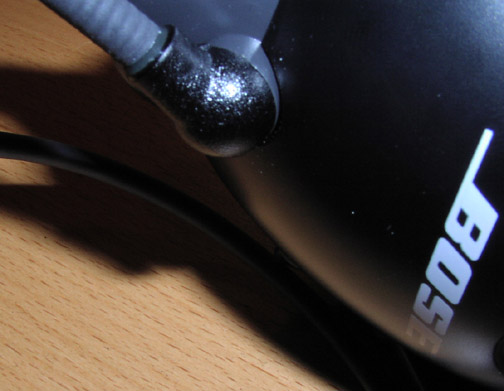
Shown above is Bose's "interesting" choice of boom mounts. Thankfully, this mount can be moved to either side of the headset (it comes with the mic on the left as with most headsets). However, I'm still forming my opinion on the quality of the boom swivel. It's nearly impossible to photograph (I tried), but if you move the boom, the black spherical component ratchets in a "coarse" manner such that the boom rotates perhaps 10 degrees. Then, the flexible boom may be used to fine-tune the position of the microphone relative to your lips. The thing that disturbes me is that it's another plastic on plastic piece that would appear to be subject to higher than average wear if used regularly. The Series I mount used a thumbscrew and a frictional pivot, and that just lended a better tactile feel than the new swivel does. Oh well...guess I'll find out in a few years just how well-designed this part is.
And lastly, here's closeup of the headset adjustment mechanism.
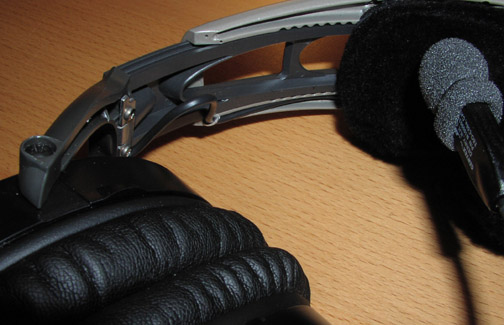
The top portion of the headband (the silver component in the top center of the picture) is magnesium, which is amazingly strong and light, but the mating surface (the part that connects the earcup to the headband) is plastic. These parts again rachet against each other and serve as the primary means to adjust the headset for different-sized heads.
This is another component set that seems inherently prone to wear, in part because it's metal against plastic when it really should be metal-metal, but primarily because if you pack your headset up each time and stick it in the nylon case Bose provides, you have to actuate these adjustments EVERY time (the case is about 2 inches vertically too small for the headset). Fortunately, I still have my Series I soft case and I'm now using that to store the headset in my bag for this very reason.
Conclusion
The Good
Overall Comfort
One of the first things you notice when you put the Bose X on, even before you hit the power switch for the ANR electronics, is how much lighter it is than the Series I. The second thing you notice is how well the headset fits. The canted earcups are great.
Phenomenal noise reduction that beats the impressive Series I
Most noticeable improvement over the Series I is in the degree to which offending noise is reduced while audio bandwidth and overall subjective quality of the receive audio has been improved. The low-level background hiss that plagued the Series I is gone. Some people have described the received audio as "tinny" but I don't see why...it sounds great by my standards.
Better power source
What really blows my mind is how they've been able to improve the performance of the ANR electronics and yet eliminate the huge brick of a battery the Series I required. On long trips, I'd have to bring the AC power brick along to charge that headset's required 14.4V NiCd battery, but no more. One or maybe two 9V alkaline batteries is all that's required for even painfully long trips. This was worth the upgrade alone. Bravo, Bose.
Better microphone
The Series I had a great mic that was leaps and bounds ahead of the David Clark M4 unit in my H10-40's but the Bose X microphone is perhaps, subjectively, 50% better in terms of audio quality. No "scratchy s's" like the David Clark, and certainly better audio bandwidth than the Series I. When I speak into this mic, I hear my voice clearly and accurately, as if I was speaking into a $1000 microphone in a recording studio (except without the reverb!). Simply amazing.
The Bad
Whether it involves a printer that requires complete disassembly to remove the one #$%!%! screw required to remove the motor assembly (thank you HP), a car that requires complete disassembly of the dash to replace the heater core (every damn car maker out there), or a top-of-the-line headset that places its operational fate in the hands of a $0.02 piece of foam rubber, I think it's safe to say that even the finest engineers can produce crap if they engineer in a vacuum (that is to say, without direct customer involvement). Unfortunately, it would appear that a few of Bose's finest have committed this very blunder. A few cases in point:
Poorly-Designed Battery Box
First, it's made of a cheap plastic and its cover is just stupidly engineered...every time I take the thing off I think I'm going to break the very fragile tab on the end of the cover that "locks" it to the box. The cover is also separate from the box, which makes me believe that if it does ever fall off, I'll lose it.
The battery is sort of crammed in there and held in place against the contacts merely by the force of some rigid foam that mates with the base of the battery. If this foam disappears or loses its physical characteristics, the battery will not remain seated and my $1000 headset is worthless. The battery box looks like one designed for a $20 toy...no kidding. If I were Bose, I'd redesign this box ASAP.
The solution? Look at any of the new digital cameras. My Olympus has spring-loaded contacts that require me to insert the batteries, press down on the cover, slide it closed, and then lock it with a latch. Far easier, far more secure, and far less likely to break.
Volume Control
I have no clue what Bose's engineers were smoking the day they came up with this ridiculous volume control, but it really irritates me when I need to quickly and easily adjust the volume level in the headset (and by the way Bose, that means in BOTH ears simultaneously).
Here's how the volume control pot should work:
- Push it in, it retracts, and handle is safe from damage
- Push it in again and it pops out. In this mode you can control the volume level in both ears simultaneously.
- Pull the knob into its outer-most detent and allow a balance adjustment.
No Auto-Power-Off (APO)
Come on guys, it's not like it would take a ton of fancy electronics to make that a reality. I'm pretty attentive when it comes to turning the power off (I got used to doing so with the Series I), but I can't understand how any engineering team could put so much effort into the design of the electronics to reduce power consumption and then drop the ball when it came to the most important power-conservation feature of them all.
Overall Rating
4/5 stars. Definitely worth buying if only to get the great ANR and audio performance, new battery (portable model only, naturally), and the usual reliable operation and great Bose customer support. However, they'll never get my vote for 5/5 or "Best Available Headset" until the design flaws are fixed.




